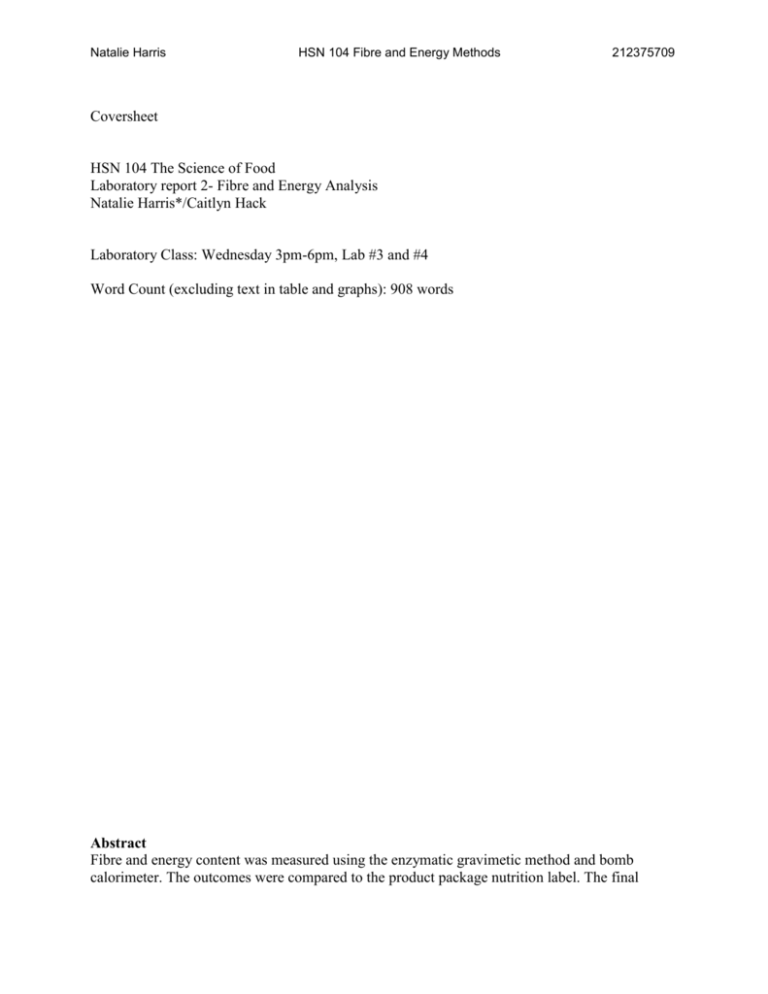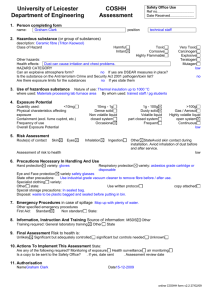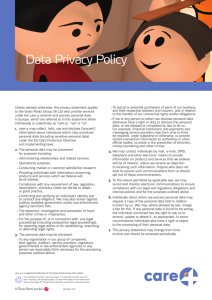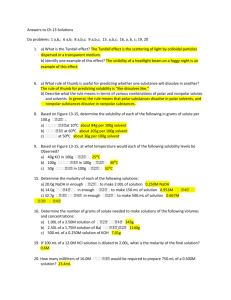Fibre and Energy Analysis
advertisement

Natalie Harris HSN 104 Fibre and Energy Methods 212375709 Coversheet HSN 104 The Science of Food Laboratory report 2- Fibre and Energy Analysis Natalie Harris*/Caitlyn Hack Laboratory Class: Wednesday 3pm-6pm, Lab #3 and #4 Word Count (excluding text in table and graphs): 908 words Abstract Fibre and energy content was measured using the enzymatic gravimetic method and bomb calorimeter. The outcomes were compared to the product package nutrition label. The final Natalie Harris HSN 104 Fibre and Energy Methods 212375709 product showed that fibre was 8.8g/100g and 18.6 kJ/g of energy, which were compared to the claims on packaging. The results found coincided with that which was claimed, representing accuracy on the labeling. 1. Introduction Manufacturers are enforced by the Australian Food Guidelines to provide accurate food nutritional panels for their consumers, the lab will focus on legitimizing these claims. This was completed through the analysis of the enzymatic gravimetric method, the AOAC method, and use of a bomb calorimeter. The enzymatic gravimetric method is responsible for analyzing fibre content. It is completed by the sample being repeatedly heated and cooled, whilst adjusting the pH and adding the given enzyme, being either alpha amylase, protease or amylogluctoidase. The addition of the three enzymes represents the digestion of starch and protein. (Redono A, Garcia B, 1992) Alpha amylase is commonly found in saliva, its main roll is to digest carbohydrates. Protease, used for digestion of proteins to alpha amylase, and amylogluctoidase digest carbohydrates into glucose. The three enzymes used break down the given macronutrient and must be kept at 60C, this increases the rate of digestion. Ethanol is the final substance added before settling overnight, at this point one is able to calculate the dietary fibre content. To determine energy by a bomb calorimeter, a sample is added to the crucible, weighed, and placed in the bomb calorimeter, which is ran by the demonstrator. Once it has fired the maximum deflect was recorded and calculation were made to determine the energy and overall calorie content. (Faculty of Health, 2012) The aim of the laboratory is to compare claimed and calculated results using the enzymatic gravimeter method and bomb calorimeter method. 2. Results and discussion (i) Total dietary fibre content of biscuits Figure 1, Personal data** and class mean of dietary fibre (g/100g) Dry, fat-free sample weight (g) Blank Biscuit 1.011 Celite + crucible weight (g) 67.800 69.731 Residue weight (g) Nutritio n Panel Fibre Conten t (g/100g ) Total dietary fibre, fatfree (g/100g) Total dietary fibre in original sample (g/100g) Class Average (g/100g) - - - - 3.24966 7 0.0952 2.857 9.5 8.8 The class mean (3.25 g/100g) and the calculated (8.8 g/100g) are much higher then the packaged claimed (2.857 g/100g). This can be caused by experimental error, including incorrect measurements, directions or calculation errors. When comparing the biscuits to the recommended fibre content by the Australian and New Zealand Food Standards, it shows the biscuits meet criteria for fibre content. The standards claim fibre must be greater then 1.5 g/100g Natalie Harris HSN 104 Fibre and Energy Methods 212375709 and the biscuits claim to be 2.857 g/100g, with a even higher class average being 3.24967 g/100g. (Australian and New Zealand Food Standards, 2012) (ii) Energy by bomb calorimetry Figure 3, Personal data*** Food Biscuit Estimated energy of fresh sample (kJ/100g) on label 1860 Actual Moisture (%) 2.7% Dry matter coefficient 0.973 Estimated energy on dry basis (kcal/g) 4.57 Estimated sample size (g) of dry sample containing 4 kcal 0.875 The bomb calorimetry is considered a old-fashioned and unreliable method. This is because it poorly coincides with the human bodies digestion, it is ironically too efficient. (Nutrition Facts and Basics, 2007). Generally, humans can harvest energy in 97% of carbohydrates, 95% of fats and 92% of proteins. This data can be used to adjust the bomb calorimetry to be more accurate. These differences are known as Atwater general factors. Recently, energy is calculated through the analysis of chemical composition of foods. This is done by determining the concentrations of macronutrients and the addition of energy value to determine the total value. Although, this is a on-going area of research. (Mullan, 2006) (iii) Determination of sugar, sodium and saturated fat content using indirect data Macronutrient Content in food (g/100g) Sugar 21.4 Sodium 192 (mg) Saturated fat 5.7 Proper labeling on nutrition labels, including sugar, sodium and saturated fat, is extremely important from a health perspective. Not only can foods high in any of those can contribute to obesity, it can also put a consumer’s life at risk by increasing the probability of developing diabetes or high cholesterol. These foods are energy dense, and can have too much fat and not enough good nutrients, such as fiber. (Putatunda) A general view at these biscuits shows that they are not healthy. There is 21.4% sugar, which is higher for a biscuit that does not taste sugary. The fat content although is not that high, normally 15-20% fat is considered a high fat food and it claims to only be 5.7%. (Nutrition Labeling, 2012) (iv) Calculation of total carbohydrate of food Natalie Harris HSN 104 Fibre and Energy Methods 212375709 This can be determines using the equation: =100- [water, protein, total lipids, alcohol, in g/100g] (Food Standards Australia and New Zealand, 2012) (v) Calculation of energy content of food This is determined through the addition of energy from protein, fat, carbohydrates, dietary fibre, alcohol and organic acids. The equation is as followed: Energy (kJ) = protein (g)*17 + sugars (g)*16 + other available carbohydrate (g)*17 + fat (g)*37 + dietary fibre (g)*8 + alcohol (g)*29 + sorbitol (g)*16 + citric/malic/quinic acids (g)*10 + lactic/acetic acids (g)*15) (Food Standards Australia and New Zealand, 2012) Using the calculation above is generally more accurate then using the bomb calorimetry. This is because it is more accurate because bomb calorimetry does not harvest the amount of energy the human body will. (vi) Preparation of a nutrition information panel Class Mean and Individual Results Nutritional Table Marie Biscuits Calculated Energy 4.57 kcal/1g or 19.13 g/100g Total dietary Fibre* 8.8 g/100g Marie Biscuits Nutritional Panel Marie Biscuits Claimed Energy 18.60 g/100g Total dietary Fibre 2.8 g/100g The class and claimed nutritional panels are a bit different but claims are relatively close. It can be predicted that differences in the claims are due to error. As one can see, the total fibre contents are very different, this is assumed to be due to misusing methods and incorrect Natalie Harris HSN 104 Fibre and Energy Methods 212375709 calculations. The enzymatic gravimetric method is recommended to be completed for a second time to obtain more accurate results. 3. Conclusion In conclusion, the laboratory session gave a great insight to how to use methods to determine fibre content and energy content. The calculated fibre content (8.8 g/100g) was much higher then the class and nutrition label content. Again, this can be due to extensive experimental error. The total energy content outcomes were fairly similar, the calculated being 19.13 g/100g and the claimed being 18.60 g/100g, this shows that there was accuracy when it came to the bomb calorimetry method. 4. References 1. Faculty of Health (2012), The Science of Food [Laboratory one and two HSN 104]. Burwood: Deakin University. 2. Cohen, Juliet. "Nutrition Facts and Basics." Articlesbase.com. Articlesbase.com, n.d. Web. 17 Sept. 2012. <http://www.articlesbase.com/nutrition-articles/nutrition-facts-and-basics177403.html>. 3. Mullan, W.M.A. (2006) . Labelling-Determination of the energy content of food. [On-line]. Available from: http://www.dairyscience.info/packaging-/119-labelling-determination-of-theenergy-content-of-food.html . Accessed: 17 September, 2012. Updated March 2012 4.Putatunda, Rita. "Fast Food Nutrition Facts." Buzzle. N.p., n.d. Web. 17 Sept. 2012. <http://www.buzzle.com/articles/fast-food-nutrition-facts.html>. Natalie Harris HSN 104 Fibre and Energy Methods 212375709 5 ) Williams, P., H. Yeatman, S. Zakrzewski, B. Aboozaid, and S. Henshaw. "Nutrition and Related Claims Made on Packaged Australian Foods." (2003): 1-32. Research Online. University of Wollongong, 2003. Web. 15 Sept. 2012. <http://ro.uow.edu.au/cgi/viewcontent.cgi?article=1019&context=hbspapers&seiredir=1&referer=http%3A%2F%2Fwww.google.com.au%2Furl%3Fsa%3Dt%26rct%3Dj%26q %3Daustralian%2520food%2520regulations%2520for%2520fibre%26source%3Dweb%26cd%3 D6%26ved%3D0CEkQFjAF%26url%3Dhttp%253A%252F%252Fro.uow.edu.au%252Fcgi%25 2Fviewcontent.cgi%253Farticle%253D1019%2526context%253Dhbspapers%26ei%3DQhFXUJ H9EfGQiQeM7oCIDg%26usg%3DAFQjCNHfeWrHusABFpdrAGYlyJU_M4p5A%26sig2%3DAX6hy9thyBg_P7_MF54dQw#search=%22australian%2 0food%20regulations%20fibre%22>. 6) "Nutrition Labelling." NSW Food Authority: Safer Food, Clearer Choices. NSW Nutrition Labelling, n.d. Web. 17 Sept. 2012. <http://www.foodauthority.nsw.gov.au/consumers/foodlabels/label-facts/nutrition-labelling/>. 7) Redondo, A, Villanmva, M J, Garcia, B . (1992). Determination of Dietary Fibre by the AOAC method in raw and processed vegetables:peas samples. Fresenius' Journal of Analytical Chemistry. 4 (4), 1-8. 8) "Food Standards Australia New Zealand." Labelling of Food -. Food Standards Australian New Zealand, 2012. Web. 14 Sept. 2012. <http://www.foodstandards.gov.au/consumerinformation/labellingoffood/>.








